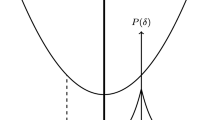Abstract
Differential Evolution (DE) is a powerful optimization procedure that self-adapts to the search space, although DE lacks diversity and sufficient bias in the mutation step to make efficient progress on non-separable problems. We present an enhancement to DE that introduces greater diversity while also directing the search to more promising regions. The Combinatorial Sampling Differential Evolution (CSDE) is introduced which can sample vectors in two ways; highly correlated with the search space or around a ‘better’ individual. The CSDE approach can provide a similar number of samples as crossover, without being biased towards the principle coordinate axes of a decision space. This approach to sampling vectors is capable of optimizing problems with extensive parameter interactions. It also demonstrates fast convergence towards the global optimum and is highly scalable in the decision space on a variety of single and multi-objective problems due to the balance between sampling highly directed correlated vectors and non-correlated vectors which contribute to sampling diversity.





























Similar content being viewed by others
References
Coello CAC, Christiansen AD (2000) Multiobjective optimization of trusses using genetic algorithms. Comput Struct 75:647–660
Deb K, Gulati S, Chakrabarti S (1998) Optimal truss-structure design using real-coded genetic algorithms. In: Genetic programming 1998: Proceedings of the third annual conference, University of Wisconsin, Madison, Wisconsin, USA. Morgan Kaufmann, Massachusetts, pp 479–486
Deb K, Khan N, Jindal S (2000) Optimal truss-structure design for multiple objectives. In: Tenth national Seminar on aerospace structures, Kanpur, India. Indian Institute of Technology, pp 168–180
Deb K, Agrawal S, Pratap A, Meyarivan T (2002) A fast and elitist multiobjective genetic algorithm: NSGA-II. IEEE Trans Evol Comput 6(2):182–197
Deb K, Sinha A, Kukkonen S (2006) Multi-objective test problems, linkages, and evolutionary methodologies. In: GECCO 2006 Genetic and evolutionary computation conference, Seattle, Washington, USA (July 8–12 2006). ACM Press, New York, pp 1141–1148
Espi MV (1998) Genetic algorithms-based methodologies for design optimization of trusses (discussion). J Struct Eng 979–980
Fleischer M (2003) The measure of pareto optima: applications to multiobjective metaheuristics. In: Proceedings of evolutionary multicriterion optimization: Second International Conference, EMO 2003 (April 8–11 2003). Lecture Notes in Computer Science. Springer, Faro, vol 2632
Hibbeler RC (2006) 14. In: Structural analysis. Pearson Prentice Hall, Upper Saddle River, pp 529–564
Ilonen J, Kamarainen JK, Lampinen J (2003) Differential evolution training algorithm for feed-forward neural networks. Neural Process Lett 7(1):93–105
Iorio A, Li X (2006) Rotated test problems for assessing the performance of multi-objective optimization algorithms. In: GECCO 2006 genetic and evolutionary computation conference, Seattle, Washington, USA (July 8–12 2006). ACM Press, New York, pp 683–690
Iorio A, Li X (2008) Rotated problems and rotationally invariant crossover in evolutionary multi-objective optimization. Int J Comput Intell Appl Spec Issue Simul Evol Learn 7(2):149–186
Lampinen J, Zelinka I (2000) On stagnation of the differential evolution algorithm. In: Proceedings of MENDEL 2000, 6th international Mendel conference on soft computing, pp 76–83
Li X, Iorio AW (2008) Improving the performance and scalability of differential evolution. In: Simulated evolution and learning: 6th international conference, SEAL 2008, Melbourne, Australia (December 7–10 2008). Lecture Notes in Computer Science. Springer, Berlin, vol 5361, p 131140
Newham LTH, Nortonb JP, Prosserd IP, Crokee BFW, Jakemane AJ (2003) Sensitivity analysis for assessing the behaviour of a landscape-based sediment source and transport model. Environ Model Softw 18(8–9):741–751
Pelikan M, Goldberg DE, Cant-Paz E (2000) Linkage problem, distribution estimation, and bayesian networks. Evol Comput 8(3):311–340
Price K (1996) Differential evolution: a fast and simple numerical optimizer. In: Biennial conference of the North American Fuzzy Information Processing Society—NAFIPS, Berkeley, California, USA (June 19–22, 1996). IEEE, vol 3339, pp 524–527
Price K (1999) An introduction to differential evolution. In: New ideas in optimization. McGraw Hill, New York
Rajeev S, Krishnamoorthy CS (1997) Genetic algorithms-based methodologies for design optimization of trusses. J Struct Eng 123:350–358
Reeves C, Wright C (1995) An experimental design perspective on genetic algorithms. In: Foundations of genetic algorithms. Morgan Kaufmann, Massachusetts, vol 3, pp 7–22
Rogalsky T, Derksen RW, Kocabiyik S (1999) Differential evolution in aerodynamic optimization. In: Proceedings of the 46th annual conference of the Canadian Aeronautics and Space Institute, Montreal, Quebec (May 3–5, 1999), pp 29–36
Ruy WS, Yang YS (2001) Topology design of truss structures in a multicriteria environment. Computer Aided Civil Infrastruct Eng 16:246–258
Salomon R (1996) Re-evaluating genetic algorithm performance under coordinate rotation of benchmark functions: a survey of some theoretical and practical aspects of genetic algorithms. BioSystems 39(3):263–278
Salomon R (1997) The evolution of dierent neuronal control structures for autonomous agents. Robot Autonom Syst 22(3–4):119–213
Storn R (1996) Differential evolution design of an IIR-filter. In: Proceedings of IEEE international conference on evolutionary computation, ICEC ’96, Nayoya University, Japan, IEEE (May 20–22 1996), pp 268–273
Sutton AM, Lunacek M, Whitley LD (2007) Differential evolution and non-separability: using selective pressure to focus search. In: GECCO 2007 genetic and evolutionary computation conference. ACM Press, London, pp 1428–1435
Whitley LD (1991) Fundamental principles of deception in genetic search. In: Foundations of genetic algorithms. Morgan Kaufmann, Massachusetts, pp 221–241
Zitzler E, Thiele L (1998) Multiobjective optimization using evolutionary algorithms—a comparative case study. In: Parallel problem solving from nature—PPSN V: 5th international conference, Proceedings (September 27–30 1998). Lecture Notes in Computer Science. Springer, Amsterdam, vol 1498, pp 292–304
Author information
Authors and Affiliations
Corresponding author
Rights and permissions
About this article
Cite this article
Iorio, A.W., Li, X. Improving the performance and scalability of Differential Evolution on problems exhibiting parameter interactions. Soft Comput 15, 1769–1792 (2011). https://doi.org/10.1007/s00500-010-0614-y
Published:
Issue Date:
DOI: https://doi.org/10.1007/s00500-010-0614-y




